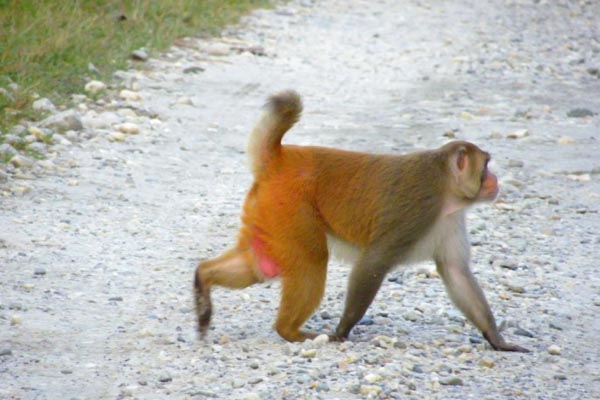ASSAMESE MACAQUE
Monkeys
Macaca assamensis
Physical Description
The Assamese Macaque is also known as the Himalayan Macaque or the Hill Monkey. The Assamese Macaque’s pelt is dark to yellowish brown in colour. The adult Macaque has red skin. The Assamese Macaque has a hairless face and cheek pouches to store food in while foraging. The Macaque’s body length measures from 50 to 73 centimetres (20 to 29 inches).
The Assamese Macaque’s short tail is between 19 and 38 centimetres (7.5 to 15 inches) long. The average body weight of the adult male Assamese Macaque is between 10 and 14.5 kilograms (22 to 32 pounds). The female weighs between eight and 12 kilograms (17 to 26 pounds).
Habitat
The Assamese Macaque inhabits mountain, evergreen, bamboo, and deciduous dry forests, at elevations from 300 to 3,500 metres (980 to 11,500 feet). The Assamese Macaque is found in Bangladesh, Bhutan, Burma, Cambodia, China, Laos, Nepal, Thailand, Tibet, and Vietnam.
Eating Habits
The Assamese Macaque eats fruits, leaves, insects, and small mammals, but prefers immature leaves.
Behaviour and Reproduction
The Assamese Macaque is active during the day, or diurnal, and spends its time both on the ground and in the trees. The Macaque is a social animal, living in hierarchical groups of 10 to 50 monkeys. Each group includes both males and females. After a gestation period of 165 days, Assamese Macaque mothers give birth to one offspring. Each offspring weighs about 400 grams (14 ounces) at birth. Males leave their mothers’ groups once they reach maturity. The life span of the Assamese Macaque is unknown.
Present Status
The Assamese Macaque is categorized as Vulnerable in the 2003 IUCN Red List of Threatened Animals. The Macaque is under first class protection in China.
Threats to Survival
The Assamese Macaque’s numbers have declined due mainly to habitat loss resulting from logging. The Macaque is also hunted for food, and is persecuted in areas where it raids crops.
References
BBC, Science & Nature – Wildfacts – Assamese Macaque, http://www.bbc.co.uk/nature/wildfacts/factfiles/216.shtml, Sept 2004.
Eudey, A. & Members of the Primate Specialist Group, 2000: Macaca assamensis. In: IUCN, 2003: 2003 IUCN Red List of Threatened Species, http://www.redlist.org, Aug 2004.
Flannery, Sean, Jan 2004: Assamese Macaque (Macaca assamensis), http://members.tripod.com/uakari/macaca_assamensis.html, Oct 2004.
By: Environment and Development Desk, DIIR, CTA.



comment 0